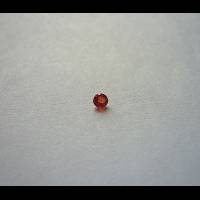Eudialyte

Mont Saint-Hilaire, La Vallée-du-Richelieu RCM, Montérégie, Québec, Canada
0.09 carats
© Giovanni Scapin 2015
Transparent to translucent red to reddish brown eudialyte can occur as crystals or masses. Well-formed crystals are very rare, but faceted stones are very popular because of their attractive colouring. Small bright red crystals come from Mt Saint Hilaire, Quebec, Canada.
The massive eudialyte makes attractive cabochons and spheres. This material is found in Kola Peninsula, Russia.
Eudialyte Gemstones by Size
This table shows distribution of Eudialyte gemstone sizes that are listed on this site. This can give a good indication as to the general availability of this gemstone in different sizes.
Contributed photos
Lightest:0.10 cts
Heaviest:0.13 cts
Average:0.11 cts
Total photos:2
Do you have a larger Eudialyte? Why not upload a photo?
| General Information | ||||||||||||||||||||||
|---|---|---|---|---|---|---|---|---|---|---|---|---|---|---|---|---|---|---|---|---|---|---|
| Chemical Formula |
| |||||||||||||||||||||
| Physical Properties of Eudialyte | ||||||||||||||||||||||
| Mohs Hardness | 5 to 5.5, Blue Chart Gem Identification (2010) More from other references | |||||||||||||||||||||
| Specific Gravity | 2.74 to 3.00, Blue Chart Gem Identification (2010) More from other references | |||||||||||||||||||||
| Cleavage Quality | Poor, Gemstones (2009) | |||||||||||||||||||||
| Fracture | Uneven, Gemstones (2009) | |||||||||||||||||||||
| Optical Properties of Eudialyte | ||||||||||||||||||||||
| Refractive Index | 1.591 to 1.633, Blue Chart Gem Identification (2010) More from other references | |||||||||||||||||||||
| Optical Character | Uniaxial/+, Blue Chart Gem Identification (2010) More from other references | |||||||||||||||||||||
| Birefringence | 0.003 to 0.010, Blue Chart Gem Identification (2010) More from other references | |||||||||||||||||||||
| Pleochroism | Weak, Gemstones (2009) | |||||||||||||||||||||
| Dispersion | Nil, Gemstones (2009) | |||||||||||||||||||||
| Colour | ||||||||||||||||||||||
| Colour (General) | Brown-red, brown, pink., Gemstones of the world (2001) More from other references | |||||||||||||||||||||
| Transparency | Translucent,Opaque, Blue Chart Gem Identification (2010) More from other references | |||||||||||||||||||||
| Lustre | Vitreous, Gemstones (2009) | |||||||||||||||||||||
| Crystallography of Eudialyte | ||||||||||||||||||||||
| Crystal System | Trigonal, Gemstones of the world (2001) More from other references | |||||||||||||||||||||
| Habit | Short rhombohedral to prismatic crystals, Gems, Sixth Edition (2006) More from other references | |||||||||||||||||||||
| Geological Environment | ||||||||||||||||||||||
| Where found: | Occurs in nepheline syenites, alkalic granites and associated pegmatites, Gems, Sixth Edition (2006) | |||||||||||||||||||||
| Further Information | ||||||||||||||||||||||
| Mineral information: | Eudialyte information at mindat.org | |||||||||||||||||||||
| Significant Gem Localities | ||||||||||||||||||||||
| ||||||||||||||||||||||
